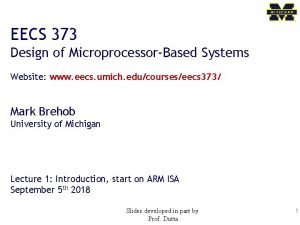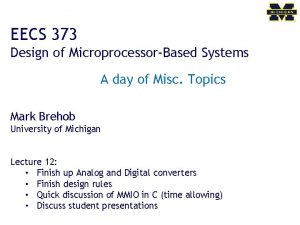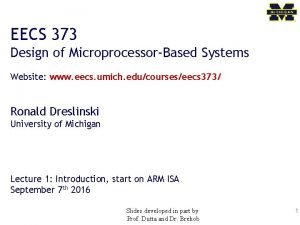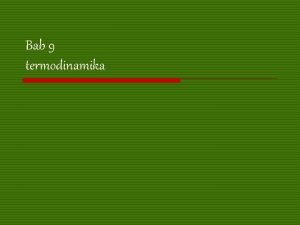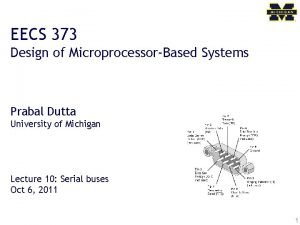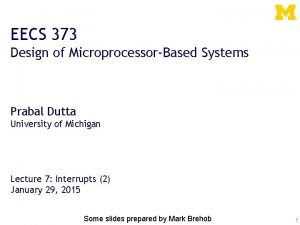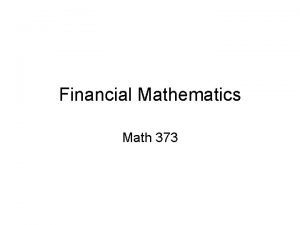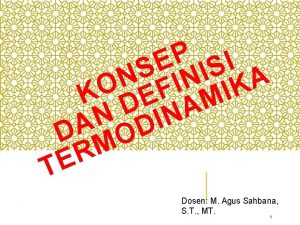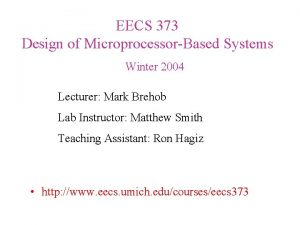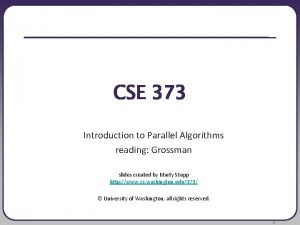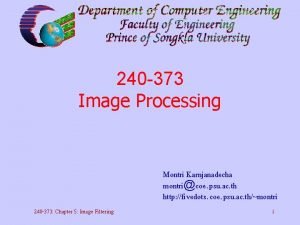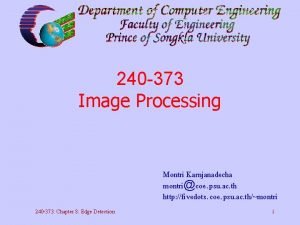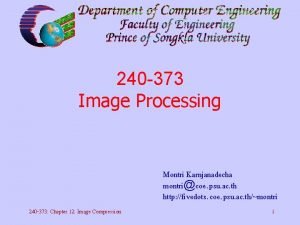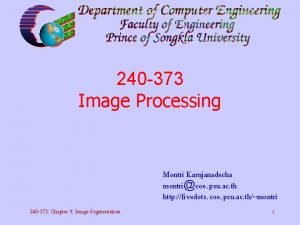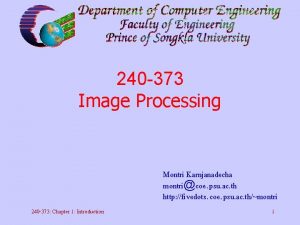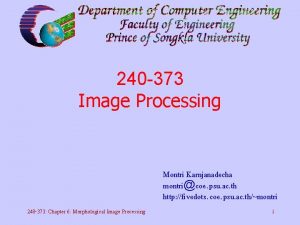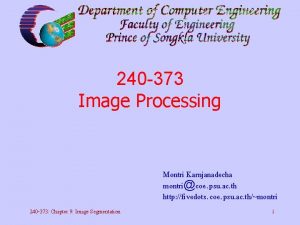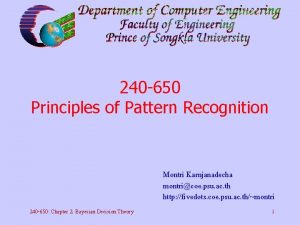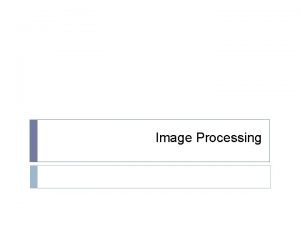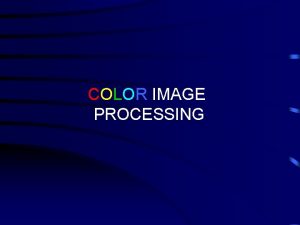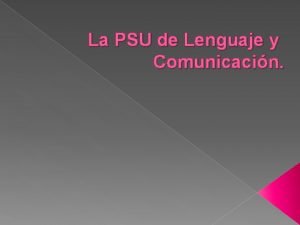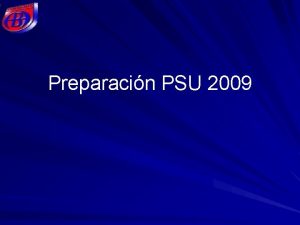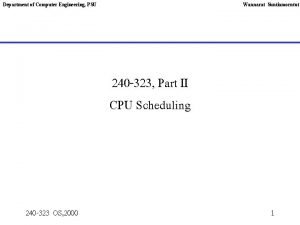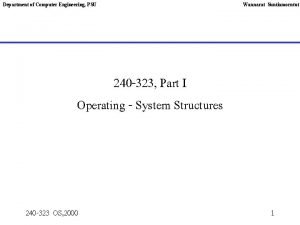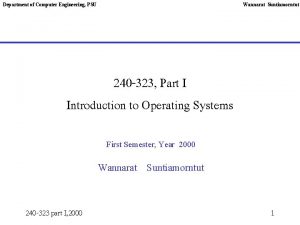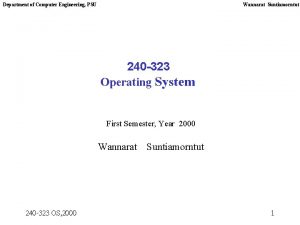240 373 Image Processing Montri Karnjanadecha montricoe psu


































- Slides: 34

240 -373 Image Processing Montri Karnjanadecha montri@coe. psu. ac. th http: //fivedots. coe. psu. ac. th/~montri 240 -373: Chapter 11: Three Dimensional Image Processing 1

Chapter 11 Three Dimensional Image Processing 240 -373: Chapter 11: Three Dimensional Image Processing 2

Three-Dimensional Image Processing • • • Spatially Three-Dimensional Images CAT (Computerized Axial Tomotography Stereometry Stereoscopic Display Shaded Surface Display 240 -373: Chapter 11: Three Dimensional Image Processing 3

Optical sectioning – Problem with conventional optical microscope: only structure near the focus plane is visible – Serial sectioning (slicing the specimen into a series of thin sections and acquiring the image of each section) can be used to solve the problem but it has 2 major disadvantages: • loss of registration when sections become separated • geometric distortions – Optical sectioning is achieved by digitizing the specimen with the focal plane situated at various levels along the optical axis 240 -373: Chapter 11: Three Dimensional Image Processing 4

Thick specimen imaging 240 -373: Chapter 11: Three Dimensional Image Processing 5

Thick specimen imaging (cont’d( – The focal length of the objective lens determines the distance df to the focal plane from the lens equation: /1 di = 1/df = 1/f and the magnification of the objective is M = di / df 240 -373: Chapter 11: Three Dimensional Image Processing 6

Thick specimen imaging (cont’d( We can place the focal plane at any desired level z’. The focal plane of the objective is related to the other microscope parameters by f = di/(M+1) = (df. M)/(M+1) = (didf)/(di+df( and the distance from the center of the lens to the focal plane is df = di/M = (M+1)f/M = fdi/(di-f( 240 -373: Chapter 11: Three Dimensional Image Processing 7

Computerized Axial Tomography (CAT( • Conventional radiography – Using X-rays – Some structures in human body absorb X rays more heavily than other structures – No lenses are used – Projection (2 dimensional) of the object is recorded – Multiple views are frequently used to resolve ambiguities 240 -373: Chapter 11: Three Dimensional Image Processing 8

Conventional radiography 240 -373: Chapter 11: Three Dimensional Image Processing 9

Tomography • Tomography – Useful where image detail is required in deeply imbedded structures such as those of the middle ear – One disadvantage: high dosage of X-ray 240 -373: Chapter 11: Three Dimensional Image Processing 10

Tomography 240 -373: Chapter 11: Three Dimensional Image Processing 11

CAT • Computerized axial tomography (CAT( – CAT is a technique that incorporates digital image processing to obtained 3 -D images – The CAT scanner rotates about the object to acquire a series of exposures – The resulting set of 1 -D intensity functions is used to compute a 2 -D cross-sectional image of the object at the level of the beam – The beam is moved down the object in small steps producing a 3 -D image 240 -373: Chapter 11: Three Dimensional Image Processing 12

CAT 240 -373: Chapter 11: Three Dimensional Image Processing 13

Stereometry • Stereometry is a technique by which one can deduce the 3 -D shape of an object from a stereoscopic image pair • Image of the object can be recorded by measuring the brightness of each pixel on the image plane • The distance from the center of the lens to the point p defines the range of this pixel • A range image can be generated by assigning each pixel a gray level proportional, not to its brightness, but to the length of its pixel cone 240 -373: Chapter 11: Three Dimensional Image Processing 14

Stereometry 240 -373: Chapter 11: Three Dimensional Image Processing 15

Stereoscopic Imaging 240 -373: Chapter 11: Three Dimensional Image Processing 16

Range equations • Range equations – Suppose that the point P, with coordinates (X 0, Y 0, Z 0) is located in front of the cameras – We can show that a line from P through the center of the left camera will intersect the Z = -f plane at 240 -373: Chapter 11: Three Dimensional Image Processing 17

Range equations – Similarly for the right camera – We now setup a 2 -D coordinate system in each image plane with a 180 o rotation, thus 240 -373: Chapter 11: Three Dimensional Image Processing 18

Range equations – Now the coordinate of the point images are and Rearranging both equations 240 -373: Chapter 11: Three Dimensional Image Processing 19

Range equations Solving for Z 0, gives the normal-range equation. – We can also write 240 -373: Chapter 11: Three Dimensional Image Processing 20

Range equations Substitute Z 0 gives the true-range equation: 240 -373: Chapter 11: Three Dimensional Image Processing 21

Range calculations • For each pixel in the left image, determine what pixel position in the right image corresponds to the same point on the object. This can be accomplished on a line-by-line basis. • Calculate the difference xr- xl to produce a displacement image, in which gray level represents pixel shift. • Using the displacement image, calculate Zo at each pixel to produce a normal range image. 240 -373: Chapter 11: Three Dimensional Image Processing 22

Range calculations • Calculate the X and Y coordinates of each point by: • Now we can calculate the X, Y, Z-coordinates of every point on the object that maps to a pixel in the camera. • Finally, compute R as a function of X and Y to produce a true-range image. 240 -373: Chapter 11: Three Dimensional Image Processing 23

Range calculations • Notes (for boresighted cameras: ( – If Z 0 >> d , the cameras must be converged to ensure that their fields of view overlap to include the objects in the near field. The range equations are slightly more complex. – If the cameras are not in the sample plane, the equations are even more complex. – Cameras geometry can be computed from a pair of stereo images. 240 -373: Chapter 11: Three Dimensional Image Processing 24

Stereo Matching • The following figure illustrates a technique that locates the right image pixel position that corresponds to a particular left image pixel. 240 -373: Chapter 11: Three Dimensional Image Processing 25

Stereo Matching – Suppose the given pixel in the left image has coordinates xl, yl – Fit the imaginary windows around that pixel and the pixel having the same coordinates in the right image – Compute a measure of agreement (using crosscorrelation-- a sum of squared differences( – Move the window in the right image to the right to find maximum agreement, thus xr-xl can be found 240 -373: Chapter 11: Three Dimensional Image Processing 26

Stereo Matching Notes: • Noise tends to corrupt the image agreement measure • Increase window size to ignore noise but this reduces the resolution of the resulting range image • It is difficult to determine the range of a smooth surface. Projection of random texture onto such surface can be helpful 240 -373: Chapter 11: Three Dimensional Image Processing 27

Stereometry with Wide-Angle Cameras • Used in Viking Mars Lander spacecraft • Two digitizing cameras (angle scanning cameras) are spaced 1 meter apart • The coordinates of a pixel are given by the azimuth and elevation angles of the centerline of its pixel cone 240 -373: Chapter 11: Three Dimensional Image Processing 28

Stereometry with Wide-Angle Cameras 240 -373: Chapter 11: Three Dimensional Image Processing 29

Stereometry with Wide-Angle Cameras • The azimuth is the angle between the yzplane • The elevation angle is the angle between the xz-plane 240 -373: Chapter 11: Three Dimensional Image Processing 30

Stereometry with Wide-Angle Cameras • Normal-range equation components in terms of the two camera azimuth coordinates and are written as follow: • – is the elevation coordinate and is the same for both cameras 240 -373: Chapter 11: Three Dimensional Image Processing 31

Stereometry with Wide-Angle Camera (Cont’d( 240 -373: Chapter 11: Three Dimensional Image Processing 32

Stereoscopic Image Display • Range relation 240 -373: Chapter 11: Three Dimensional Image Processing 33

Stereoscopic Image Display • If the relationship DS = fd is satisfied, the scene will appear as if the observer had viewed it firsthand • Two conditions must be met to obtain accurate reproduction of a 3 -D scene: – There should be converging lenses in front of each of the viewer’s eyes so that the viewer can focus his/her eyes at infinity and still see the two transparency in focus. Positive lenses of focal equal to D are commonly used – The viewing geometry is exact only when the viewer’s line of sight falls along the z-axis. 240 -373: Chapter 11: Three Dimensional Image Processing 34
 Neighborhood processing
Neighborhood processing Image enhancement by point processing
Image enhancement by point processing Histogram processing in digital image processing
Histogram processing in digital image processing Nonlinear image processing
Nonlinear image processing Image processing
Image processing Morphological
Morphological Image transform in digital image processing
Image transform in digital image processing Noise
Noise Compression in digital image processing
Compression in digital image processing Key stage in digital image processing
Key stage in digital image processing Fidelity criteria in digital image processing
Fidelity criteria in digital image processing Image sharpening in digital image processing
Image sharpening in digital image processing Geometric transformation in digital image processing
Geometric transformation in digital image processing Digital image processing diagram
Digital image processing diagram Image transform in digital image processing
Image transform in digital image processing Image geometry in digital image processing
Image geometry in digital image processing Noise
Noise Eecs373
Eecs373 Eecs 511
Eecs 511 Eecs 373
Eecs 373 Suatu sistem menyerap kalor 1500 kalori dari lingkungannya
Suatu sistem menyerap kalor 1500 kalori dari lingkungannya Eecs 373
Eecs 373 Eecs 373
Eecs 373 Math 373
Math 373 Kapasitas kalor molar suatu gas ideal
Kapasitas kalor molar suatu gas ideal Eecs 373
Eecs 373 Drg koder
Drg koder Marty stepp
Marty stepp Top-down vs bottom-up processing
Top-down vs bottom-up processing Bottom up processing vs top down processing
Bottom up processing vs top down processing Bottom-up processing examples
Bottom-up processing examples Secondary processing
Secondary processing Parallel processing vs concurrent processing
Parallel processing vs concurrent processing Top bottom processing
Top bottom processing What is interactive processing
What is interactive processing

















